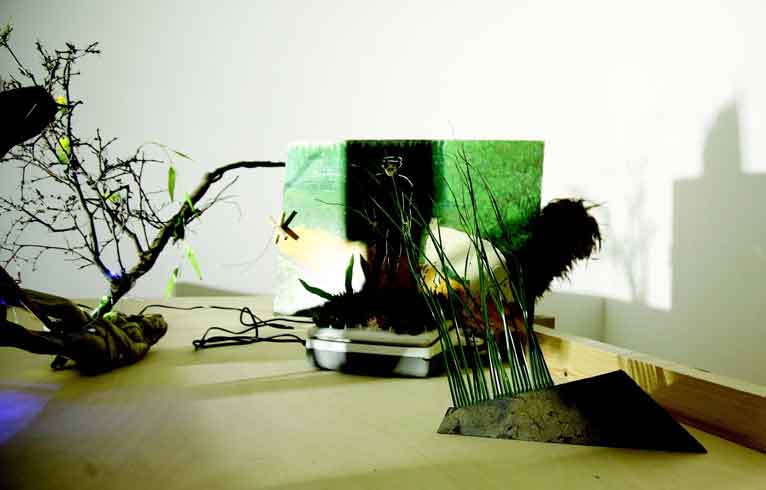THE THIRD PARTY
| May 12, 2011 | Post In LEAP 8

“The Third Party” is divided by curator Beatrice Leanza into three parts, labeled, like a traditional theatrical production, according to the convention of “acts.” These three acts all have their own themes—“How to Be Alone,” “The Stranger,” and the final act, “(Long Live) The Third Party”—each separated by about a week. Owing to the format of the exhibition, only audience members who come out for all three acts can fully comprehend the context for each unit. An audience that lacks a deeper understanding of the ecology of Chinese contemporary art can only hope to discover the relationships among these acts in the fixed details of the exhibition arrangement on their own. The exhibition is limited to the right side of one of Platform’s several galleries; the manner in which the work is presented relies heavily on Li Naihan’s hexagonal architectural installation, The Beehive. But looking at the “The Third Party” exhibition as a whole, its design presents the relationship between the three acts as nothing more than external, experiential clues; the exhibition possesses a kind of everyday, makeshift aesthetic that renders the more deeply rooted interconnections among the acts as convoluted and ambiguous. How is it that all the way up to the third act, “The Third Party”—as the theme of the exhibition—still poses a question for us? Is it possible that this “Third Party” is just a floating signifier, one passing through all three acts and revealing its meaning only in its independent relationship to each individual act?
fLeanza’s concept behind the choice of works only becomes clear with the final act, “(Long Live) The Third Party.” For the most part these pieces are the product of the artists’ self-organized projects and alternative spatial practices. In 2010, “self-organization” and “alternative spaces” together constituted an overarching trend in Chinese contemporary art. These alternative spaces, now increasingly solidified in gallery mechanisms—experimental nodes like Homeshop or Arrow Factory that occupy residential hutongs—implement strategies in conversation with “ordinary” social space; regardless of what they ultimately accomplish, they are at the very least conscious reflections upon the structural position and force of contemporary art in society. On the other hand, active participants in selforganized groups such as Left Behind, Double Fly, and Company use a model of discursive exchange, engaging in a kind of shared mode of expression in order to break down fixed aesthetic and intellectual formulas.
Revisiting the first two acts with this in mind, “How to Be Alone” reveals the norms that inform the practices of twenty different artists— or perhaps, the individual circumstances of each artist—and simultaneously provides the individual with survival tips to utilize within the social space; whereas “The Stranger” offers a more puzzling scene; it is a presentation of cooperation among artists, as well as artists’ misappropriations of the mysterious images of political figures. In a way, the act sums up the previous act’s treatment of the everyday, functioning as a kind of aesthetic détournement; at the same time, it seems to kick-start the next act’s considerations of the value of social space. In light of this, “The Third Party” carried out an aesthetic discussion that is grounded in the present state of China’s contemporary art practice. It is a step-by-step attempt to expound upon, search for, and establish—within the context of the everyday—an internal, driving force that fuels artistic practice in the world of contemporary art. Yet the audience, in confronting a scene of such marked “subtlety,” may have trouble grasping its more profound implications. In this way, “The Third Party” perhaps becomes a conversation best understood by those already on the inside. Sun Dongdong

